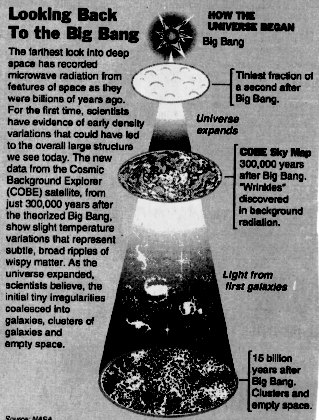ENERGY: PRIMITIVE FORMS
In order to understand which energy forms are available on Earth, we need to briefly summarize here the origin of our Universe. Astrophysicists and cosmologists have developed, in remarkable detail, the so called 'Big Bang' theory (see, for example, New York Times, April 24, 1992):

- In the beginning (about 15 billion years ago), what we know of today as the Universe was concentrated in a tiny mass called the 'cosmic egg'; this mass erupted in a 'Big Bang' and all the energy that we know of today was thus created in the form of elementary particles of matter (protons, neutrons, photons, electrons, etc.).
- In this explosion, matter was converted into several forms of energy (e.g., radiation, nuclear energy, gravitational energy) as the Universe
expanded and cooled. For a fascinating account of what happened during the first three minutes after the Big Bang, see Steven Weinberg's "The First Three Minutes", published by BasicBooks, 1993. (If you really get intrigued by the ultimate fate of the Universe, you might want to browse through "The Last Three Minutes", by Paul Davies, also published by BasicBooks, 1994.)
- About 300,000 years after the Big Bang, the temperature decreased to approximately 3000 degrees; atoms, molecules, planets, stars and galaxies began to form. Our Sun is about 5 billion years old; it is expected to shine for at least another billion years. So we shall not run out of energy any time soon. (We shall soon run out of some specific energy forms - for example, chemical energy stored in petroleum. This is a good reason to be concerned about energy issues in general and energy policies in particular. The so called 'energy crises' of the seventies were really just signals that only petroleum resources are being depeleted at an alarmingly fast rate, especially in the industrialized nations.)
Here is a convenient brief history of time.
15 billion years ago:
Formation of the Universe.
5 billion years ago:
Formation of our solar system.
300 million years ago:
Formation of fossil fuels on Earth.
65 million years ago:
Disappearance of dinosaurs from the face of the Earth.
10 million years ago:
Appearance of distant relatives of humans on Earth.
10 thousand years ago:
Appearance of first human civilizations.
Today:
Humans wondering how to satisfy their ever increasing appetite for energy.
Brief introduction to NUCLEAR ENERGY:
The early universe was incredibly hot and dense. Three minutes after its formation (or creation), the temperature was a billion degrees. It was then cool enough for the protons and neutrons to combine and form nuclei of deuterium (a form of hydrogen, consisting of one proton and one neutron) and helium (consisting of two protons and two neutrons). A huge amount of energy was stored in these nuclei, as well as in others (e.g., uranium) that were eventually formed on our planet. We refer to this energy stored in the nucleus of an atom as nuclear energy.
Brief introduction to GRAVITATIONAL ENERGY:
As the universe cooled further, 300,000 years after the Big Bang, electrons combined with nuclei to form atoms, and atoms combined with other atoms to form molecules. Further clustering of matter, made possible by additional cooling of the universe, resulted in the formation of planets, stars, galaxies and other 'heavenly bodies'. The law of universal gravitation, discovered by Isaac Newton in 1687, applies to these and other objects (e.g., pool of water collected behind a dam, somewhere high up in the mountains): the force of attraction between two bodies is proportional to the product of their masses and inversely proportional to the square of the distance between them. When this law is applied to our planet, the acceleration due to gravity (g) appears as a fundamental constant, with a value of about 10 meters per square second. The expression for the gravitational potential energy also appears, as the product of mass, acceleration due to gravity and distance from the surface of the Earth.
Brief introduction to CHEMICAL ENERGY:
As life on Earth developed, plants and trees began to grow. This growth was made possible by the process of photosynthesis in which solar radiation is stored within the molecules of plants and trees. This stored solar energy is called chemical energy. Of special interest is the chemical energy of substances called fossil fuels, which were formed by anaerobic decay of prehistoric plants and trees. When these substances are subsequently combined with oxygen in a process called combustion (or burning), the stored solar energy is released in the form of heat.
lrr3@psu.edu (revised 8/26/96)

